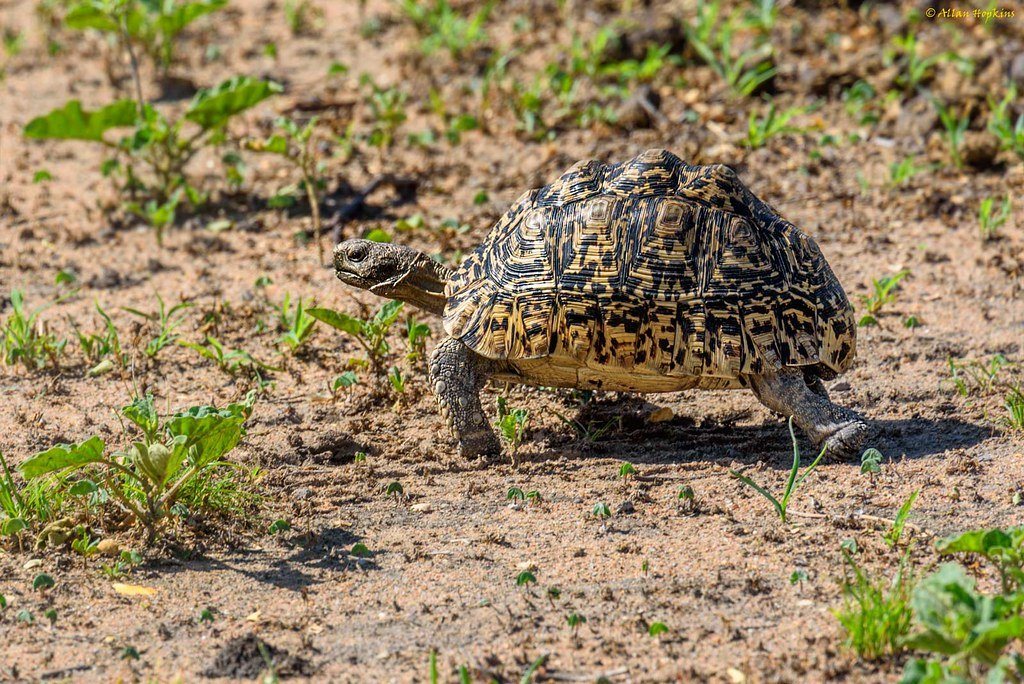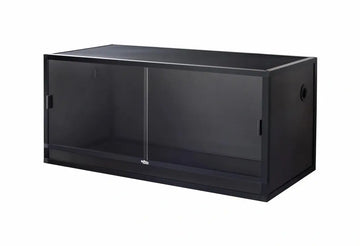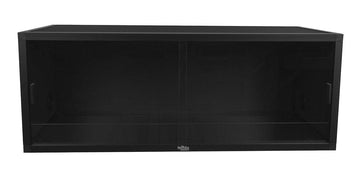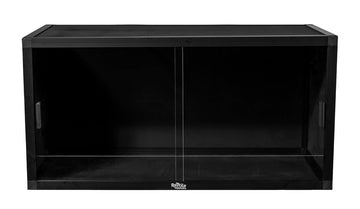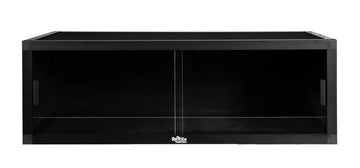The leopard tortoise (Stigmochelys pardalis) is a 12-28” long tortoise native to southeast Africa. Their preferred habitat is fairly flexible, as they are known to live in semi-desert and scrub as well as grassland and forest.
Leopard tortoises generally have highly-domed shells and slightly pyramided scutes. Base color is light brown to yellow, with a pattern of black blotches or speckles, although some individuals have a boxy pattern or none at all.
Leopard tortoises are fairly hardy, but as one of the largest tortoises in the world, leopard tortoises can be hard to house. Combine this with the fact that they can live up to 100 years, and you’re looking at a pet that shouldn’t be taken casually.
Minimum enclosure size for leopard tortoises
Young leopard tortoises can be kept indoors in a 4’L x 2’W terrarium for the first few years of their life. Adults can be housed in indoor pens, but due to their size, it’s best to house them outdoors.
A leopard tortoise pen should measure at least 10’ x 10’, with an opaque wall at least 18” tall to prevent pacing. Climbing and digging is rarely a concern with this species. However, the pen should be well secured against potential thieves and predators. If you live in a climate that experiences periods of temperatures below 60°F, you will need to provide temporary indoor housing, as leopard tortoises do not hibernate.
Cohabitation (housing multiple animals in one enclosure) is optional, but do not house males and females together unless you intend to breed them. Males should not be housed together, as they are likely to fight.
Do leopard tortoises need UVB?
Yes, leopard tortoises require exposure to UVB in order to maintain good health. Leopard tortoises housed outdoors do not need artificial UVB lighting, as they get all the UVB they need from exposure to sunlight. Leopard tortoises housed indoors, however, do need artificial UVB lighting.
The best UVB bulbs for leopard tortoises are:
- Arcadia T5 HO 12%
- Zoo Med T5 HO Reptisun 10.0
The bulb should be roughly half the length of the enclosure and mounted in the Arcadia ProT5 or Vivarium Electronics fixture. Place the lamp 17-18” above the tortoise’s shell to achieve the right strength for your tortoise.
Since leopard tortoises need such large enclosures, indoor enclosures require more illumination than just a UVB bulb can provide. Use a 6500K LED or T5 HO fluorescent grow light for this purpose.
Lights should be on for 14 hours/day during summer and 10 hours/day during winter to encourage natural hormonal cycling.
Best temperature for leopard tortoises
Like other reptiles, leopard tortoises are cold-blooded, which means that they rely on external temperatures to manage their own body temperature and metabolism. A reptile’s enclosure should offer a range of temperatures to allow them to thermoregulate effectively.
Leopard tortoises housed outdoors should have access to a warm climate that does not drop below 60°F during the day and is fairly dry. Part of the enclosure should be shaded. If night temps drop below 60°F, you will need to build a heat tortoise “house” inside the enclosure maintained at 60-70°F.
Leopard tortoises housed indoors will need at least a cluster of halogen flood heat bulbs to create a basking area large enough to evenly heat the tortoise’s entire shell. Basking temperature should be around 95°F. Ambient temperatures should be between 75-85°F. These temperatures should be measured with digital probe thermometers placed on opposite ends of the enclosure.
Heat lamps should be at least 8” away from the top of your tortoise’s shell. Do not use ceramic heat emitters (CHEs), red bulbs, or blue bulbs, as these are not as effective. However, CHEs and radiant heat panels are appropriate for use at night when necessary.
Best humidity levels for leopard tortoises
Leopard tortoises do best in moderately dry conditions (around 40-50%), but they still need humid microclimates to use when required, especially when they’re young.
For leopard tortoises housed outdoors, the most important thing is to make sure that the enclosure is not perpetually moist or wet. Rainfall should be relatively infrequent. Occasionally hosing down the shaded part of the enclosure can be helpful in dry climates.
For leopard tortoises housed indoors, provide a humid hide on the cool side, lined with moistened sphagnum moss or substrate. Humidity should be monitored via digital probe hygrometer, with the probe placed in the middle of the enclosure.
Best substrate for leopard tortoises
Leopard tortoises need a substrate/bedding that replicates their natural habitat. For tortoises housed outdoors, what you already have in your yard should be fine. However, if you have perpetually moist soil, then it’s best to excavate the soil at least 2’ down and replace it with sandy soil.
Plain topsoil mixed 60/40 by volume with play sand works well as an indoor or outdoor substrate. It should be at least 3” deep and completely replaced every 3-4 months in indoor enclosures. Remove poop and urine daily.
You can also use a thick layer of clean timothy, Bermuda, orchard grass, or similar hay for indoor substrate. This must be completely replaced daily.
How to decorate a leopard tortoise enclosure
An empty terrarium makes for a bored tortoise, reducing its quality of life. Keep your pet entertained and engaged with its environment with the strategic use of décor items that encourage it to exercise natural behaviors!
Here are some ideas to get you started:
- additional hiding places/burrows
- logs
- live, edible plants
- large, flat stones
The more stuff you add, the more functional your enclosure is likely to become! As an additional feature, you can shape the substrate into hills to create more environmental variety for your pet.
For outdoor enclosures, experts recommend planting a variety of drought-tolerant, edible weeds and grasses for the tortoise to graze on. Small shrubs also make for good shelters. The Tortoise Table is a helpful resource for figuring out which ones are safe to use.
What to feed to a leopard tortoise
Leopard tortoises are herbivores, which means that they need a high-fiber, plant-based diet to stay healthy. Variety is key to good nutrition, but your tortoise’s diet should still be about 90% grasses and weeds, and about 10% “salad” greens and vegetables. Flowers can be used as treats.
Safe grasses/leaves for leopard tortoises: lawn grass, mulberry leaves, grape leaves, hibiscus leaves, meadow hay, oat hay, orchard hay, timothy, clover, dandelion, nasturtium, geranium, coreopsis
Safe greens and vegetables for leopard tortoises: cactus pads, kale, collard greens, turnip greens, romaine lettuce, squash, white mushrooms, sweet potato
Edible flowers like nasturtium, dandelions, geranium, roses, and hibiscus are great to add for variety and extra vitamins. Do not use flowers from florists, as these are usually covered in chemicals.
Offer food every day on a plate or tray to prevent substrate ingestion.
Supplements
You will also need calcium and vitamin supplements to prevent your tortoise from developing a potential deficiency. A little bit of Mazuri tortoise diet or Zoo Med Natural Grassland Tortoise Food makes a nutritious addition to your tortoise’s salad. You will also need a cuttlebone present in the enclosure at all times for calcium.
Water
Of course, don’t forget a water bowl! For drinking water, offer a shallow dish large enough for the tortoise to soak as desired. Hatchlings should be soaked (supervised) 1-2x/week. The water should be no deeper than their elbows.
Keep the water clean at all times and scrub the dish weekly with a reptile-safe disinfectant.
How to handle your leopard tortoise
Tortoises in general don’t like being handled, and this can be nearly impossible with an adult leopard tortoise, as they’re very heavy anyway! However, if you want to interact with your tortoise, try hand-feeding or giving it light rubs on the head or shell.
*This care sheet contains only very basic information. Although it’s a good introduction, please further your research with high-quality sources. The more you know, the better you will be able to care for your pet!
"Leopard Tortoise (Stigmochelys pardalis), male" by Allan Hopkins is licensed under CC BY-NC-ND 2.0

